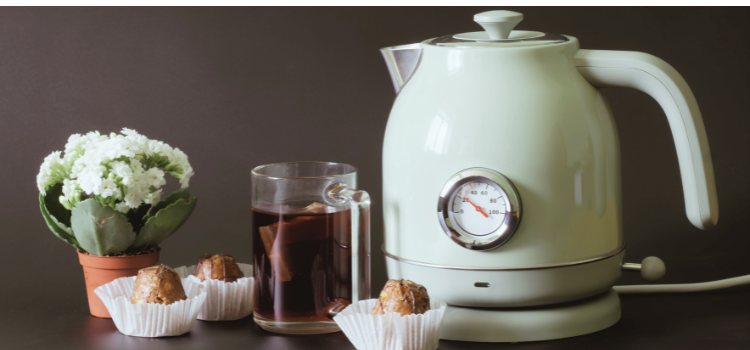Electric kettles have become an essential kitchen appliance, offering convenience and efficiency. However, with increasing environmental awareness, many are asking whether their electric kettle is eco-friendly. The materials, energy consumption, and design features of an electric kettle can all impact its environmental footprint. In this article, we’ll explore what makes an electric kettle eco-friendly, highlight key features to look for, and offer some of the best options for those who want to enjoy their hot drinks while reducing their impact on the environment.
Why Consider an Eco-Friendly Electric Kettle?
Choosing an eco-friendly electric kettle benefits both the environment and your wallet. Eco-friendly kettles are typically designed to minimize energy consumption, use sustainable materials, and last longer, ultimately reducing waste. Whether you’re a tea lover, coffee enthusiast, or simply need a quick way to boil water, a sustainable electric kettle can make a difference.
Here are some key benefits of using an eco-friendly electric kettle:
- Energy Efficiency: Eco-friendly kettles consume less electricity, helping you save on your energy bills while reducing your carbon footprint.
- Sustainable Materials: Many eco-friendly kettles are made from BPA-free, recyclable materials, ensuring minimal environmental impact.
- Longer Lifespan: A durable, well-made kettle reduces the need for frequent replacements, thus decreasing waste.
- Health Benefits: Eco-friendly electric kettles are often free from harmful chemicals like BPA, which can leach into boiling water from plastic components.
Let’s dive into the features to look for when selecting an eco-friendly electric kettle.
1. Energy Efficiency: Look for Fast-Boil Technology and Insulation
One of the most important features of an eco-friendly electric kettle is energy efficiency. Kettles with higher wattage boil water faster, meaning they consume less energy over a shorter period. Many eco-friendly kettles offer quick-boil technology, allowing you to save time and electricity.
Key Features to Look For:
- High Wattage: Kettles with 1500 to 3000 watts are ideal for fast boiling. Although higher wattage means more power usage, the speed of boiling reduces the overall energy consumption.
- Insulated Design: Double-wall or vacuum-insulated electric kettles help retain heat, so water stays hot longer. This reduces the need to re-boil, saving both energy and time.
The best electric kettles for eco-friendliness will be those that strike a balance between power and speed. Some models even have energy-saving modes or “eco-modes,” which allow you to boil smaller amounts of water without wasting electricity.
2. Material Matters: BPA-Free, Recyclable, and Stainless Steel Options
Another critical aspect of an eco-friendly kettle is its material. Many traditional electric kettles are made from plastic, which can leach harmful chemicals like BPA when exposed to high heat. Stainless steel and glass are popular materials for eco-friendly kettles due to their durability, safety, and recyclability.
Materials to Consider:
- Stainless Steel: This material is durable, rust-resistant, and recyclable. It’s also better for maintaining water taste as it doesn’t impart any flavors.
- Borosilicate Glass: Glass kettles are typically BPA-free, easy to clean, and give you a clear view of the water level. Look for models with borosilicate glass, as it’s heat-resistant and less likely to shatter.
- BPA-Free Plastic: While plastic is less eco-friendly than glass or stainless steel, some BPA-free plastics are designed for safe boiling. If you prefer a plastic kettle, make sure it’s labeled BPA-free.
Choosing the right materials can impact not only the kettle’s eco-friendliness but also the taste and quality of the water you’re boiling. The best electric kettle options are typically made with stainless steel interiors and minimal plastic.
3. Capacity and Fill Line: Avoiding Waste
A common issue with traditional electric kettles is that people often boil more water than they actually need, which wastes energy. Eco-friendly kettles are designed with visible water level indicators, allowing you to boil only the amount you need.
Look for These Features:
- Clear Fill Line: A transparent window or an internal marker allows you to see how much water you’re adding, reducing the likelihood of overfilling.
- Variable Capacity: Some kettles offer the ability to heat small amounts of water, perfect for when you only need one cup. This saves time and energy, as the kettle doesn’t need to work as hard.
When searching for the best electric kettle for eco-friendly use, opt for models that make it easy to boil the exact amount of water you need. This not only conserves energy but also reduces your utility costs over time.

4. Temperature Control for Efficient Heating
If you enjoy a range of hot drinks, an electric kettle with temperature control is an excellent choice. Different beverages require specific temperatures for optimal flavor, and boiling water unnecessarily wastes energy.
Why Temperature Control Matters:
- Precision Heating: Tea and coffee have ideal brewing temperatures. Green tea, for example, is best brewed at around 175°F, while black tea and coffee are better around 200°F. An electric kettle with temperature settings allows you to avoid overheating and wasting energy.
- Customizable Presets: Some eco-friendly kettles come with programmable settings, making it easy to select the right temperature without guesswork.
Temperature control can be especially useful if you’re looking to prepare different types of tea or coffee, as it ensures you’re only heating the water to the exact degree needed, saving both energy and time.
5. Safety Features: Auto Shut-Off and Boil-Dry Protection
Safety is an important aspect of eco-friendliness in an electric kettle. When a kettle boils dry or is left on too long, it not only damages the appliance but also consumes more energy than necessary.
Essential Safety Features to Look For:
- Auto Shut-Off: Automatically turns off the kettle when the water reaches a boil, preventing wasted energy and reducing fire hazards.
- Boil-Dry Protection: This feature shuts off the kettle if it detects no water inside, preventing overheating and conserving energy.
Eco-friendly electric kettles with these features not only enhance safety but also reduce energy consumption by ensuring the appliance only operates when necessary.
6. Longevity and Durability: Invest in a Quality Kettle
A high-quality electric kettle can last for years, while cheaper, poorly made models may break down after a short period, leading to more waste. Investing in a durable, eco-friendly kettle minimizes your environmental impact over time.
What to Look For:
- Reputable Brand: Choose brands known for quality and durability. The best electric kettles come from companies with a commitment to sustainability and long-lasting products.
- Solid Construction: Look for sturdy materials like stainless steel or thick glass and avoid flimsy plastic parts.
- Warranty: A good warranty is an indicator of quality and reliability. Many eco-friendly kettles come with warranties that cover several years, giving you peace of mind.
Quality electric kettles may cost a bit more upfront but will save you money and reduce waste in the long run.
7. Eco-Friendly Accessories and Maintenance
Using eco-friendly accessories and maintaining your electric kettle can further enhance its efficiency and lifespan. Descaling your kettle regularly, for instance, keeps it working efficiently and ensures you get clean, fresh-tasting water.
Recommended Eco-Friendly Accessories:
- Natural Descaling Solution: Limescale buildup can impact both the efficiency and taste of your water. Vinegar and lemon juice are natural, eco-friendly descalers that keep your kettle clean.
- Reusable Filter: If you have hard water, consider a kettle with a built-in or reusable water filter to reduce mineral deposits. These filters can improve water quality and help your kettle last longer.
By maintaining your kettle and using eco-friendly accessories, you’ll not only extend its life but also ensure it remains energy-efficient.
The Best Eco-Friendly Electric Kettles to Consider
For those looking to make a conscious choice, here are some of the best electric kettle that stand out in terms of eco-friendliness, efficiency, and design:
1. Mueller Ultra Kettle
- Material: Borosilicate glass and stainless steel
- Features: Fast-boiling, BPA-free, auto shut-off, and LED indicator
- Why It’s Eco-Friendly: Uses durable, recyclable materials with minimal plastic.
2. Breville BKE820XL
- Material: Stainless steel
- Features: Variable temperature settings, auto shut-off, boil-dry protection
- Why It’s Eco-Friendly: Offers precise temperature control, reducing unnecessary energy use.
3. Fellow Stagg EKG Electric Kettle
- Material: Stainless steel
- Features: Variable temperature, quick-boil, auto shut-off
- Why It’s Eco-Friendly: Built to last with quality materials and customizable temperatures.
Final Thoughts: Choosing an Eco-Friendly Electric Kettle
An eco-friendly electric kettle is a smart choice for anyone who wants to reduce their environmental impact without sacrificing convenience. When selecting a kettle, consider features like energy efficiency, sustainable materials, temperature control, and durability. By investing in a quality kettle that aligns with eco-friendly standards, you’ll save energy, reduce waste, and enjoy a hot cup of tea or coffee guilt-free.
Whether you’re looking for the best electric kettle for daily use or eco-friendly options for the long term, there’s a perfect model out there that balances speed, functionality, and sustainability.




